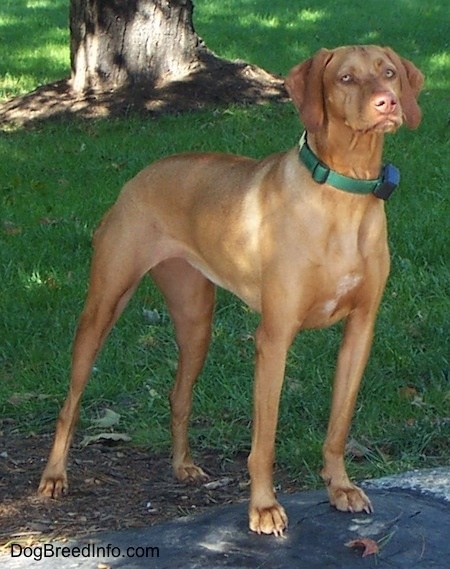
Illie the Vizsla
VEEZH-lah 
The Vizsla is a medium-sized hunting dog. The strong body is slightly longer than it is tall. The slightly domed skull is lean and muscular and wide between the ears with a medial line going down the forehead. The muzzle tapers gradually from the stop to the nose and is the same length or shorter than the skull. The nose is flesh-colored in contrast with the coat. The neck is strong with no dewlap. The teeth meet in a scissors bite. The medium-sized eyes contrast with the coat color. The long ears are silky thin, hanging down close to the cheeks with rounded tips. The tail is thick at the root and is customarily docked to 2/3 its original length. Note: docking tails is illegal in most parts of Europe. The front legs are straight with cat-like feet. The dewclaws are usually removed. The short, smooth coat is tight to the whole body and comes in a rusty-gold color in various shades on the body.
The Vizsla is expressive, gentle and loving. Keen and trainable to a high degree, it needs daily mental stimulation. It needs a patient, calm, firm hand. If this breed does not see you as a strong authority figure it will become stubborn. Reliable with children, loving to play for hours. Without extensive daily exercise these dogs may be too energetic and excitable for very young toddlers, but are excellent for energetic kids. Able to adapt quickly to family life, and are generally good with other dogs. They are very athletic, and when lacking in exercise they may become destructive or neurotic. Socialize them well to people, places, noises, dogs and other animals. It is very important to obedience train your Vizsla. Without enough exercise, they can be overly eager, prancing around you in sheer excitement. This breed is highly trainable and very willing to please—if you can get them to understand exactly what it is you want of them. If you do not train this breed they may become difficult to handle and control. Example: See Video of a Vizsla that needs more exercise. Notice how very eager-to-please the dog is, yet she has more built up energy than she knows what to do with. She is obviously stressed and not relaxed. Vizslas tend to chew. This breed is not for everyone. If you want a calm dog and are not willing to walk a couple of miles or jog at least one mile a day, do not choose a Vizsla. Without proper exercise, they can easily become high-strung. They have many talents such as: tracking, retrieving, pointing, watchdog and competitive obedience. The Vizsla is a hunting dog and may be good with cats they are raised with, but should not be trusted with animals such as hamsters, rabbits and guinea pigs etc. Be sure to always be your dog’s pack leader to avoid any negative behaviors such as guarding furniture, food, toys and so on. Well-balanced Vizslas that receive enough exercise and have owners who are true pack leaders will not have these issues. These behaviors can be reversed once the owners start displaying leadership, discipline and provide enough exercise, both mental and physical.
Height: Males 22 - 26 inches (56 - 66 cm) Females 20 - 24 inches (51 - 61 cm)
Weight: Males 45 - 60 pounds (20 - 27 kg) Females 40 - 55 pounds (18 - 25 kg)
Prone to hip dysplasia.
The Vizsla is not recommended for apartment life. It is moderately active indoors and does best with at least an average-sized yard.
This is an energetic working dog with enormous stamina. It needs to be taken on daily, long, brisk walks or jogs. It makes a great rollerblading or bike riding companion. In addition, it needs plenty of opportunity to run, preferably off the leash in a safe area. If these dogs are allowed to get bored, and are not walked or jogged daily, they can become destructive and start to display a wide array of behavioral problems.
About 12-15 years.
About 6 to 8 puppies
This smooth, shorthaired coat is easy to keep in peak condition. Brush with a firm bristle brush, and dry shampoo occasionally. Bathe with mild soap only when necessary. The nails should be kept trimmed. These dogs are average shedders.
Vizslas are depicted on etchings that date back to the 10th century. They originate from Hungary bred by the Magyars, who used them as hunting dogs. They are thought to have descended from several types of pointers along with the Transylvanian Hound and the Turkish Yellow Dog (now extinct). "Vizsla" means "pointer" in Hungarian. The dogs worked as hunters, their superb noses and endless energy guided them to excel at catching upland game such as waterfowl and rabbit. The breed almost became extinct after World War II. After the war, when the Russians took control of Hungary, it was feared that the breed would disappear from existence. In an attempt to save the breed, native Hungarians smuggled some of the dogs to America and Austria. The Vizsla has two cousins, one with hard-wirehair called the Wirehaired Vizsla and the other a rare longhaired Vizsla. The longhaired can be born in both smooth and wirehair litters, although this is quite a rare occurrence. The longhaired Vizslas are not registered anywhere in the world, but some can be found in Europe. Some of the Vizsla's talents include retriever, pointer, game bird hunter, obedience competitions, agility and watchdog.
Gun Dog, AKC Sporting
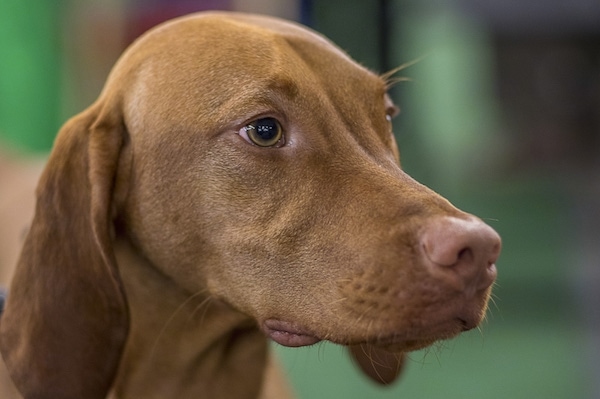
An adult Vizsla dog—Photo courtesy of David Hancock
"These are photos we took of our Vizsla pup Patton when he was a little over three months old. He lives up to the "Versatile Vizsla" nickname. He lives to retrieve on land and in the water, and he loves tracking a dummy with quail scent. He has been extremely easy to train. Because of this we are considering competing in obedience trials and keeping hunting for fun.
"But he is so smart we have to make sure he is not simply working us for treats. He's the most balanced dog in the neighborhood. Without exercise and patient, firm training, however, we don't think he would stay this way. It's essential to be a pack leader. Otherwise, he would walk all over my wife and me, choosing which commands to follow at his discretion.
"We walk/run Patton for at least 45 minutes every morning, rain or shine. We also give him time to "hunt" when we put him on a 20-foot check cord to retrieve and track. This gives him plenty of sniff time at the end of his regular exercise, and also lets us work on his ranging and heeling. Tapping into his breed instincts keeps him content. You can see the dedication and purpose on his face when he works.
"Every evening he goes to the local dog park, where he is part of a regular pack of similar, stable dogs. The combination of exercise, obedience training and socialization has prevented any bad behaviors for developing.
"Always remember: a tired Vizsla is a happy Vizsla. They need to run and romp."
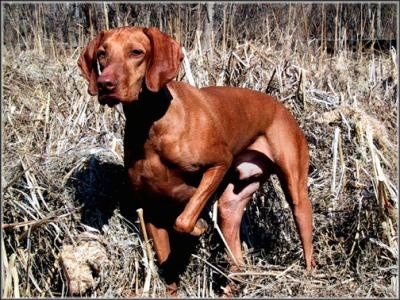
Gunner the Vizsla pointing
Illie the Vizsla waiting for her owner’s command
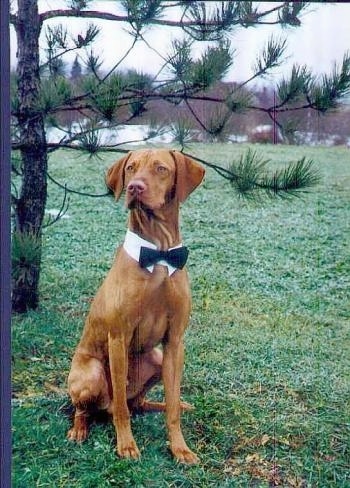
This is Kadar aka Digger's Rousing Rebel.
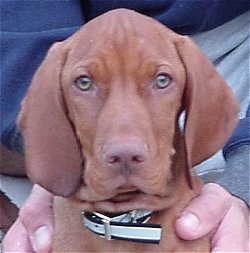
Toby the Vizsla puppy at 11 weeks old